Ipswich Union Workhouse
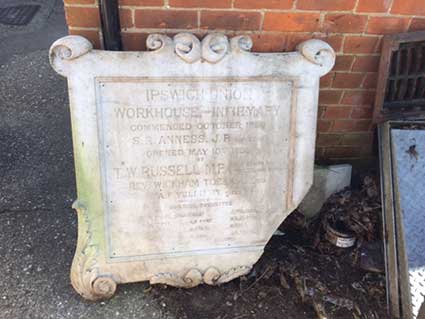
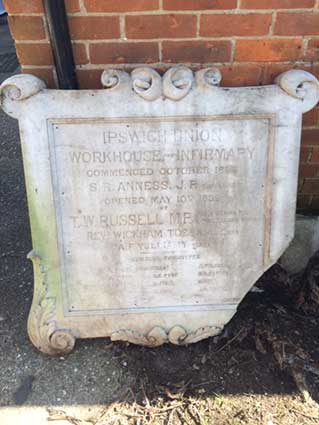 Photos courtesy Steve Girling
Photos courtesy Steve Girling
‘Hi. Thought these might be of interest to your website, this
tablet is at the Heath Rd Hospital site in a yard with no public access
so many people may not know that it exists. Regards, Steve Girling’
Many thanks to Steve for unearthing this lost fragment of Ipswich
history. The decorative carved tablet reads (some characters
speculative):
‘IPSWICH UNION
WORKHOUSE AND INFIRMARY
COMMENCED OCTOBER 1898
S.R. ANNESS. J.P.
CHAIRMAN
OPENED MAY 1O
TH 1899
BY
T.W. RUSSELL M.P.
PARLIAMENTARY SECY.
OF THE LOCAL GOVT. BOARD
REV
D. WICKHAM TOZER.
CHAIRMAN
A.F. VULLIAMY.
CLERK
———
BUILDING COMMITTEE
A. RAPHAEL. (CHAIRMAN) A. FULCHER. C.
BORRETT. H.R. EYRE. S.A. KENNEY. R.H.
CAUTLEY. C. FENN. A. LORD. H.
CHAPMAN. C. FISK. J.A. SMITH.
ARCHITECTS. MESSRS.
SALTER & ADAMS. & MR. H.
LISTER
NEWCOMBE.
BUILDERS. MESSRS. G. GRIMWOOD &
SONS.’
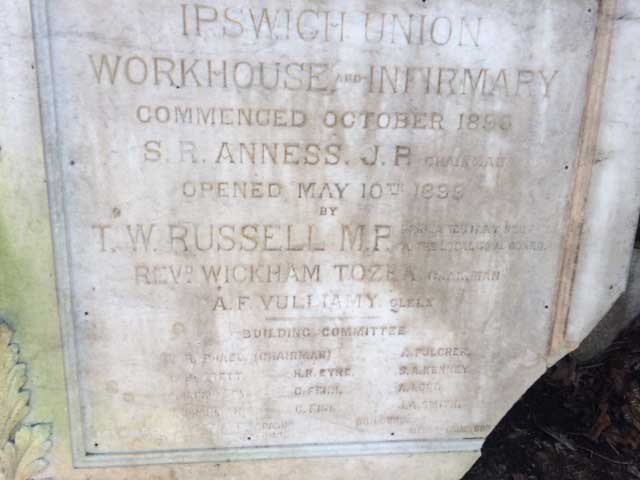
Below: close-ups with broken corner of the tablet (discoloured)
showing smaller lettering.
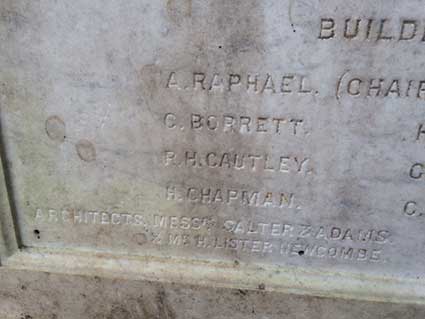
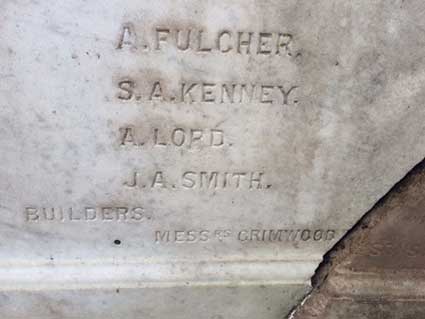
Note the reappearance of the name of the Chairman, Reverend
Wickham Tozer, who appears on the list of local worthies connected to Rosehill Library, which see for a
note on Tozer's role the Akenham Burial Case.
[UPDATE 6.6.2020:
Nicholas Raphael got in touch from Sydney, Australia to say that the
Chairman of the Building Commiittee listed here is his third great
uncle – Alderman Abraham Raphael Jr. For Nic's full
message, see our Old Jewish Cemetery
page.]
Ipswich workhouses
They began their existence in the county in the second half of
the 16th century. The workhouse within Christ's Hospital in Ipswich was
at the very forefront of this new method of providing assistance to the
poor and needy of society:-
Christ's Hospital (Borough
Workhouse): 1572-c.1600 (30 places).
A parliamentary report of 1777 listed a
dozen parish workhouses in operation in Ipswich: St Clement
(with accommodation for up to 70 inmates), St Helen (10), St Lawrence
(25), St Margaret (100), St Mary at Elms (10), St Mary at the Key (25),
St Mary Stoke (30), St Mary Tower (30), St Matthew (30), St Nicholas
(20), St Peter (28), and St Stephen (24).
Great Whip Street (Union
Workhouse, alias The Spike): 1837-1899 (400 spaces);
(moved to Heathfields Poor Law
Institution):
1899-1930 (400 spaces).
Background
In England and Wales a workhouse, colloquially known as a
'Spike', was a place where those unable to support themselves were
offered accommodation and employment. The earliest known use of the
term dates from 1631.
The origins of the workhouse can be traced to the Poor Law Act of 1388,
which attempted to address the labour shortages following the Black
Death in England by restricting the movement of labourers, and
ultimately led to the state becoming responsible for the support of the
poor. But mass unemployment following the end of the Napoleonic Wars in
1815, the introduction of new technology to replace agricultural
workers in particular, and a series of bad harvests, meant that by the
early 1830s the established system of poor relief was proving to be
unsustainable. The New Poor Law of 1834 attempted to reverse the
economic trend by discouraging the provision of relief to anyone who
refused to enter a workhouse. Some Poor Law authorities hoped to run
workhouses at a profit by utilising the free labour of their inmates,
who generally lacked the skills or motivation to compete in the open
market. Most were employed on tasks such as breaking stones, crushing
bones to produce fertiliser, or picking oakum using a large metal nail
known as a spike, perhaps the origin of the workhouse's nickname.
Life in a workhouse was intended to be harsh, to deter the able-bodied
poor and to ensure that only the truly destitute would apply. But in
areas such as the provision of free medical care and education for
children, neither of which was available to the poor in England living
outside workhouses until the early 20th century, workhouse inmates were
advantaged over the general population, a dilemma that the Poor Law
authorities never managed to reconcile.
As the 19th century wore on, workhouses increasingly became refuges for
the elderly, infirm and sick rather than the able-bodied poor, and in
1929 legislation was passed to allow local authorities to take over
workhouse infirmaries as municipal hospitals. Although workhouses were
formally abolished by the same legislation in 1930, many continued
under their new appellation of Public Assistance Institutions under the
control of local authorities. It was not until the National Assistance
Act of 1948 that the last vestiges of the Poor Law disappeared, and
with them the workhouses.
Up to 1834,
the
story can
be traced on our Tooley's and Smart's Almshouses
page and our Christ's Hospital
School page.
Piecemeal provision of poor houses in each parish were largely funded
from bequests from the estates of wealthy citizens.
The Old Poor Law
By the Poor Law Act of 1601, the parish was made the unit responsible
for the care and employment of the poor. Every household and land
occupier was rated (rather like Council Charge) and the money paid into
a parish fund. Two villagers, usually farmers or tradesmen, were
elected each Easter, as Overseers, to administer the Poor Law, the
parish fund and the needs of the poor. The Act classified the poor into
three groups:-
1. the helpless, who through age, infirmity, short-term illness,
accident or personal crisis, were unable to work or fend for
themselves; these had to be cared for by the parish.
2. the able-bodied but unemployed; these had to be found work, so they
could provide for their families.
3. those who could, but would not work ; these were to be punished in
Houses of Correction. See our Woodbridge
page for a surviving ‘Correction’ sign.
In practice most parishes provided for the helpless and able-bodied
unemployed, by means of out-relief: the giving of money, food, fuel,
clothing and medical care in their own homes. A minority of parishes
placed their helpless in a ‘poor house’, rather like today’s concept of
sheltered accommodation. By 1776 less than 20% of Suffolk parishes had
a workhouse, in which the poor were maintained in exchange for work,
usually spinning and weaving. An inventory of Assington workhouse in
1808 shows that the 23 paupers were provided with 18 spinning wheels,
two reels and a loom to work on. At Long Melford, in 1802, the 29
paupers were employed in wool combing and spinning. During that year
they produced 644lbs of combed wool ready for spinning and 84lb of spun
yarn.
House of Industry
Many towns starting with Bristol in 1696, set up a single large
workhouse to accommodate the poor from all the parishes within the town
boundary. Sudbury, in Suffolk, united its three parishes in 1702 and
Bury St Edmunds its two in 1747. Rural parishes, in the east and
southeast of Suffolk, adopted the same idea and based on the ancient
Hundred areas, closed all the poor and workhouses and built a large
central House of Industry. The aim was to reduce the cost to the
ratepayers, by cutting down administrative charges. Between 1757 and
1781, nine Houses of Industry, covering nearly 50% of parishes, had
been built in Suffolk. A survey of these Houses was made by
Thomas Ruggles and published by Arthur Young in 1794. The poor were
employed in all the Houses to comb and spin wool for Norwich clothiers.
Four of the nine Houses also spun hemp into linen, used to make
pauper’s clothing. In addition, at Oulton, near the coast at Lowestoft,
they made nets for the herring fishery; at Bulcamp, shoes and stockings
and at Nacton, ropes, sacks and plough lines were produced.
The New Poor Law
The dual system of parish workhouses and Houses of Industry ended in
1834. Population increases, rising unemployment in rural areas and
economic depression, following the Napoleonic wars, had led to a
massive increase in expenditure on the poor. Edwin Chadwick was
appointed, by the Government, to devise a more effective, national
system of maintaining the poor. His solution, based on the earlier
ideas of Jeremy Bentham and evidence from the Suffolk Houses of
Industry, was that the 15,000 parishes of England and Wales should be
formed into 600 Union districts, each with a central workhouse. Thus
the New Poor Law was partly based on the earlier Suffolk system. The
New Poor Law was the first instance of a nationwide organisation, being
controlled by central government. The Poor Law Commissioners and Board
laid down uniform rules and regulations, which were applied to every
pauper in every workhouse in England and Wales.
The never-realised aim was to end out-relief and make all paupers go
into the workhouse. Daily life was intended to be monotonous; the food
to be just below the quality of that available to the poorest family
who kept themselves out of the workhouse; the work tedious and
repetitive and often pointless. Even though the new workhouses were
often of the same design as prisons and seen as such by the inmates,
anyone could leave if they wanted to. But if they had no employment
there was little choice between starvation and the workhouse.
Pre-Union Workhouses
In Ipswich relief of the poor was reorganised in 1835 to comply with
the previous year’s New Poor Law. Three Relieving Officers replaced the
parochial overseers and most of the old poor houses were shut. The
inmates at this time totalled 176; these were divided between the three
largest poor houses: St Margaret’s for women and girls, St Clement’s
for men and boys and St Mary-Le-Tower for the aged and infirm. It is
worth noting that slums were a Victorian phenomenon; the word first
appears in an 1812 dictionary. Unemployment in rural areas led to mass
migration to the towns to seek work. This in turn led to a huge demand
for accommodation – something which became increasingly profitable for
those who owned land and any sort of buildings. Overcrowded,
poorly-built housing with insanitary conditions and lack of hygiene led
swiftly to high mortality rates, particularly amongst the infants. Drunkenness
and lawlessness accompanied the selling, churning
populations of the slums. The main focus of slum dwelling in Ipswich
was the Parish of St Clement which included ‘The Potteries’ and streets
running south from St Helens Street down to the river, as mentioned in
our page on Courts & yards. By the
1830s the problem of slum-living became an issue which could not be
ignored by the authorities. However, much of the early moves to
alleviate the problem stemmed from philanthropists.
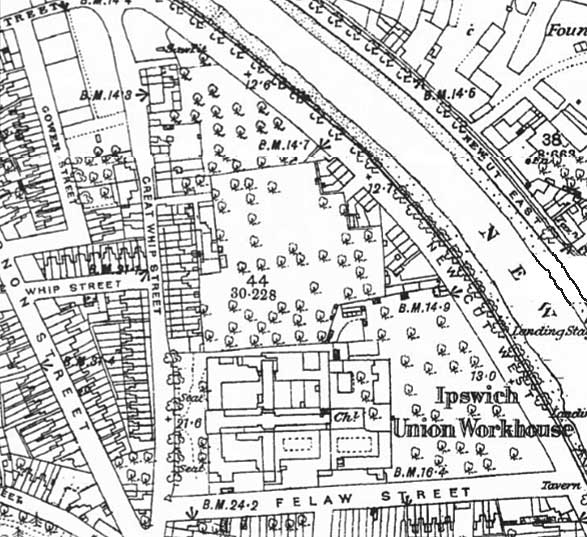
Great Whip Street Workhouse
('New Union Workhouse' or St Peter's Workhouse)
In England and Wales a workhouse, colloquially known as
a
'Spike'. This may have been due to the use of a metal nail
or spike to tease out rope fibres. The new, purpose-built Union
Workhouse was built between Great Whip Street and the Orwell in 1837
with a capacity for 400 people. Everyone from the other three houses
were transferred there. Townsmen usually located institutions which
dealt with ‘undesirables’ away from the town centre, so perhaps Over
Stoke was seen as a suitably remote place to deal with the destitute. The
Great Whip Street workhouse location and layout are
shown on the 1848 and 1867 maps on our Felaw
Street page.
The ghostly image of the workhouse appears in the background of a
pre-1883
photograph of St Peter's Vicarage on our Bridgeward
Club page.
It is also shown in the background of Davy's illustration of the laying
of the Wet Dock lock foundation stone, 1839. 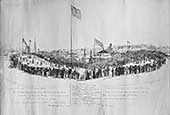
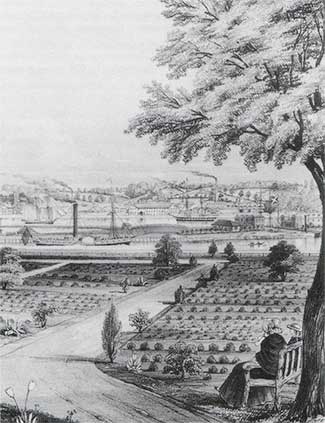
Above: An engraving of apparently idyllic orchards
and gardens of the Great Whip Street Workhouse can be seen as
propaganda. In the distance a paddle steamer and other shipping can be
seen on the Orwell.
The men – as in most of the rest of Suffolk – were set to pick
oakum;
this is is a the tedious process of unraveling set lengths of
tarred ship’s ropes into fibres to be used in shipbuilding for caulking
or packing the joints of timbers. Other work included making rush
matting, pumping water, or grinding corn, by hand crank wheels or by a
tread-wheel (a device common in prisons), gardening and farming the
workhouse land to grow wheat, oats and potatoes. During a 14 hour
workhouse day, between 6am and 8pm, the able-bodied paupers spent 10
hours, from 7am to 12pm and 1pm to 6pm, at work. The boys were
set to mend shoes and the women and girls to knit. Nobody was now paid
for their work.
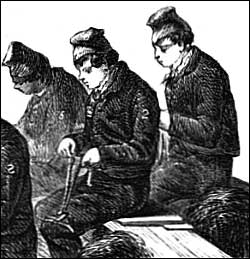 Oakum pickers
Oakum pickers
Women were also given domestic work to do, including scrubbing floors,
forms and tables with cold water and soda. They also laundered clothes,
looked after the infants and helped to nurse the sick. Vagrants, or
tramps, known as Casual Paupers, would be given a night’s shelter in
exchange for work the next morning. For men, this was picking 1lb of
oakum and for women, 3 hours washing, scrubbing and cleaning.
Although designed mainly to provide work for the able-bodied poor, by
the end of the 19th Century the workhouse had become a combination of
hospital, lunatic asylum, old people’s home and school. Costs
were cut as demand for relief rose. Life within the workhouse was
almost unremittingly bleak, yet some lived their whole lives within its
confines. An engraving of apparently idyllic orchards
and gardens of the Great Whip Street Workhouse can be seen as
propaganda.
"The paupers on their first
admission will have a comfortable apartment..."
An insight into conditions in 'St Peter's Workhouse' can be
gleaned from this report in the East
Anglian Daily Times, 26 November 1880 sent to us by Lisa Smith,
to whom our thanks:-
"IMPORTANT ALTERATIONS AT ST. PETER’S
WORKHOUSE, IPSWICH
For a long time the question of cooking at the Workhouse has been one
of the most difficult subjects with which our Board of Guardians have
had to deal. It has been such a constant source of complaint and
expense that at last the Board decided “take the bull by the horns,”
abolish the whole of the old troublesome apparatus, and in its place
have a perfect system of steam cooking. To carry this out, a committee
was appointed, consisting of Mr. F. Turner, Mr. W. Flake, and Mr. H.M.
Elton. After going carefully into the whole thing, these gentlemen came
to the conclusion that, properly carried out, the use of tea, would not
only effect a great saving in the coal bill for cooking purposes, but
that if the system were extended to the baths and wash-houses, economy
would result to such an extent that the first outlay of the apparatus
would be quickly covered. The committee favoured the system of Messrs.
Barford & Perkins, and the Board adopting the report, the work has
been satisfactorily done by that firm.
Though Messrs. Barford & Perkins’s system involves the introduction
of an apparently complex service of pipes, it is in reality simplicity
itself. A large boiler is fixed in any part of the building, and from
this steam is conveyed to the most remote corner. At the Ipswich
Workhouse an old outhouse near the kitchen has been converted into the
engine-room, and here is now fixes a three-horse-power vertical boiler
or steam generator fitted with self-feeding apparatus. From this a pipe
is led into the kitchen, and connected with a cooking apparatus,
comprising a steam closet and three coppers, two of 60 gallons each,
and one of 40 gallons. Of the two larger of these one is used for soup,
and the other for tea, whilst the smaller is devoted to the concoction
of gruel.
The steam chest is provided with four trays, and is capable of cooking
puddings, meat, potatoes, fish, or anything the fancy of an individual,
or the rules of an institution such as a Workhouse, may dictate, for a
party of 500. At the top is a jointed pipe for supplying each of the
coppers with water, and at the back is an indicator,so that the cook is
able to tell whether the stoker is attending to his duties properly. At
present the waste steam from the cooking apparatus passes out into the
sewer, but is to be utilised for the purpose of warming the dining
hall. The apparatus does away with three coppers and furnaces. Pipes
also pass on to the old boiling room and provide hot and cold water at
all times for the scullery requirements.
So much for the cooking at the House, but the greatest and most
important alterations are those with reference to the baths and
lavatories. The old bath-rooms were dark and damp places, brick
floored, and fitted with large blue slate tanks placed close up to the
wall. In the case of the old men, the bath-room and the dormitories
were at opposite ends of the buildings, and the inmates had to march
through cold draughty passages not only to get to the baths, but also
on their return from immersion in hot water. In the infirmary the sick
had to cross the yard to go to their bath-room, which was a lean-to
shed used as a scullery, in which a slate tank had been put. This bath
has for some years been one of the causes of complaint of the
Government Inspector. The sides of the baths were also high and narrow,
so that the old folks could with difficulty get in, and more than once
one of these unfortunate people has had a fall in the attempt, and
sustained severe bruises.
Primitive as these were, there were only three in the house for the
men, and two for the women. Now eleven rooms have been fitted up with
baths, including a separate one which has been termed the “itch ward,”
an addition which the officers fully appreciate. These baths are all of
red concrete, cased in wood at the sides and tops, and are fitted with
hot and cold water and waste taps. These are both cheap and
substantial, and have also the further advantage of cleanly appearance,
which is more than can be said of the old slate tanks. The floors of
the bath-rooms are also boarded, and those attached to the sick wards
furnished with a fire-place. On either side of the house there is also
a large tank, that on the men’s side holding 100 gallons, and that on
the female side 150. These are made on the jacketed principle, that is
to say with a space between the pan holding the water and the side of
the tank. The cisterns are fitted with self-feeding apparatus, and so
fill themselves with cold water.The steam from the boiler already
described circulates in this space, and heats the water to boiling
pitch in a very short time. Pipes lead from these tanks, and convey the
hot water to the various parts of the building for the baths and
lavatories.
The laundry is likewise included in the reform. The three old coppers
have been turned out of doors, and their places taken by boiling parson
the same style as the jacketed tanks just mentioned. The eleven washing
pans round the sides of the place are retained, but each will be fitted
with a cold water tap. From these taps they will be filled, and the
steam turned on to each separately, and in five minutes boiling water
is ready for the washerwoman’s hands.In one tank the soap is
dissolved by steam, in the same manner. If properly managed,
these alterations will effect a saving in this part of the house alone
of from 20 to 25 per cent. The steam from the boiling pans is carried
round the walls to the drying room. Here, that which is condemned is
taken away, whilst that still of use is carried on to the drying
closet, and utilised for drying the linen.
The work thus done by this one generator and furnace was formerly
carried on at immense labour and in anything but a satisfactory manner
by 14 large coppers, each heated by a separate furnace. This furnaces
consumed about five tons of coal a week. The new boiler only consumes
about two tons of steam coal, a saving on that item alone of three tons
of coal a week. The laundry, which is supplied by steam in this manner,
is about 300 yards from the generator, and in all about a mile of
piping is used in the building. It should also be mentioned that high
pressure is not necessary to carry on the work. We saw the cooking
apparatus, and the hot-water tanks going with only a pressure of
between two and three pounds of steam. The contract for the apparatus
and fixing £337, and it is estimated that this outlay will be entirely
covered by the first two years’ saving.
All the work has been carried out, under the superintendence of the
Committee, Mr. Eyton taking the most active share, by Mr. Eley, the
representative of Messrs. Barford and Perkins, who is also engaged in
fixing a similar boiler at St. John’s Home. At this institution,
however, the full system has not yet been adopted, though we venture to
think this can only be a matter of time, as the advantages are so
patent that the Guardians cannot long hold their hands. We might also
mention that Messrs. Barford and Perkins’s apparatus has been adopted
at the Bury St. Edmund’s Workhouse, and at Depwade, Pulham Market. For
large establishments no more economical system can be found, and we
would commend it to the attention of all who have the management of
workhouses, asylums, or places of like character.
But the improvements at the Workhouse do not end with these new bath
rooms etc. A thorough system of earth closets has been fixed in the
room of the abominable old places hitherto in use. The old female
receiving ward, a place with a brick floor, lighted by a window in the
roof 18 inches square and thoughtfully provided with two open
ventilators, having been taken as a bath-room, the infant’s school-room
is to be converted into a receiving ward, so that the paupers on their
first admission will have a comfortable apartment with a boarded floor
and well lighted. The same improving hand is visible all through the
house, and everything is done to make life within the walls bearable.
This work has been carried out by the inmates, the only cost being that
of the materials, and those of our readers who may feel inclined
to inspect the place, will, we are sure, in no way begrudge the outlay.
The alterations will all be completed in about a week, or fortnight at
the outside, and we may add that then the master (Mr. H. Sidney) will
be only too pleased what has been effected to anyone who will pay him a
visit. It now only remains for us to congratulate the committee upon
the manner in which they have discharged their duty. The changes have
entailed a large amount of time and thought, but the result fully
compensates for this, and we have no doubt that the Board generally
will thank them most heartily for their valuable assistance."
After this lengthy exposition, one might assume that the Workhouse
would continue for many years, however by the time of an article in The Ipswich Journal (12 September
1896) vigorous discussions were conducted to decide on the contractor
to build a new (replacement) Workhouse on the eastern edges of Ipswich
at Heath Road.
Heath Road Workhouse and
Infirmary
The workhouse in Over Stoke lasted only sixty-two years or so. It
cannot have been built to a good standard as one writer describes it
towards the end of its life as 'crumbling'. After thirty years of
encouragement/demands by the Poor Commission, an expensive (and
extensive) new workhouse was built from 1896 on heathland at the east
end of
Woodbridge Road – today this is known as Woodbridge Road East. It was known
as Heathfields Poor Law Institution and it was one of the last
workhouses built in England. The
redbrick receiving block and Porter's Lodge stood here until late 2015
acting for a number of years as the Borough's
Homeless Families Unit, eventually giving way to a large
modern health centre. The workhouse complex opened in 1899 and was
built with special regard for the sick and elderly; the rest of the
residents were almost by definition deemed lazy or, at best, immoral.
Although listed as having capacity for 400 souls, some say that it was
around 500. By 1912 it housed 385 inmates and 17
officials.
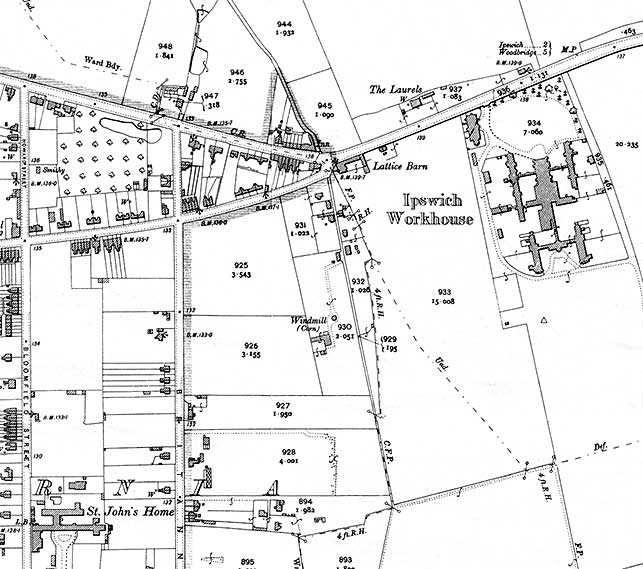 1902 map
1902 map
The 1902 map detail of the north-east corner of the California estate
(above) shows Woodbridge Road running east-west along the upper part of
the image. Spring Road meets it at the 'Lattice Barn' – still standing
at this time (the public house named after it was built over the road).
Working from the far right: Heath Road as we know it today, Lattice
Avenue and Goring Road were yet to be built, as was Colchester Road
which would eventually join Woodbridge Road just east of the Workhouse
Porter's Lodge. The geographical relationship between
the Workhouse and St John's Home (at lower left, as mentioned below) is
clear here.
In the early 20th century it was decided to change the Victorian name
of Union Workhouse to 'Heathfields'. The Union was dissolved in 1930
when Poor Law Unions and their Boards of Guardians were dissolved and
the task of dealing with poverty was made the responsibity of the
Ipswich Corporation's
Public Health Department. The workhouse continued as an 'Old People's
Home' and eventually served as the nucleus of the new general hospital
in the 1970s, eventually replacing Anglesea
Road Hospital in the early 1980s. The site has seen several modern
developments down Heath Road.
St John's Children's Home
During the 1870s up to 235 workhouse children, initially not all from
the Ipswich Union, were rehoused. St John's Children's Home opened at
the southern end of
Bloomfield Street on the California
estate in 1879. See our Brickyards
page for an 1883
map of the Bloomfield Street brickyards showing 'St John's Home' to the
south. Our 1902 map above shown the Home in relation to the Heathfields
Workhouse. 'Freelands' as it became known was demolished in the 1970s
and was
eventually replaced by housing.
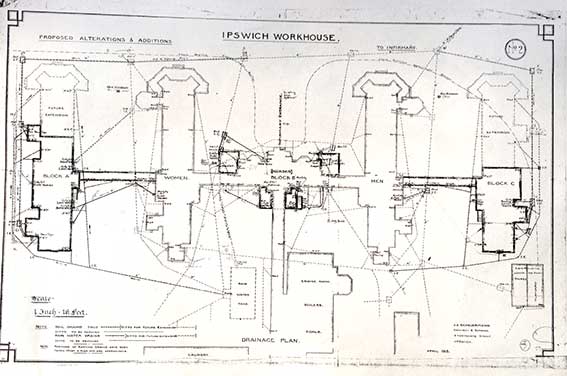
'Thought these might be of interest too although they are
drainage plans they show a basic layout of the workhouse. Kind regards,
Steve Girling'. These plans give an idea of the
'pavillion-style' and extent
of the The Ipswich Workhouse on the east of the town. As so often
occurs, this complex formed the
basis for Heath Road Wing ('H.R.W.') of Ipswich General Hospital,
which supplemented health services provided at the Anglesea Road Wing ('A.R.W.'), which opened
in 1836 as the Ipswich & East Suffolk Hospital. By 1988 all
hospital services had moved to Heath Road and the site at the north of
Berners
Street was used to build a care home, retaining the eye-catcher portico.
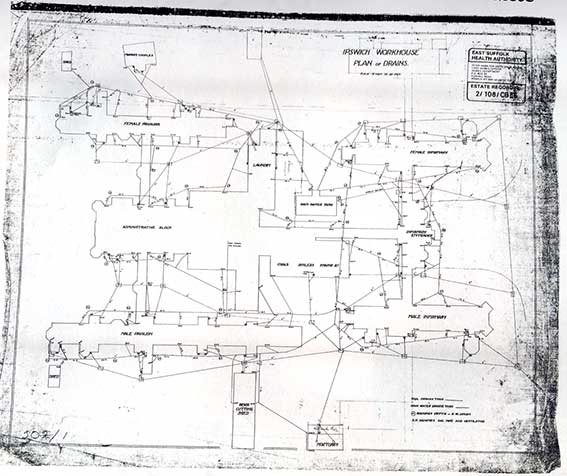
Steve Girling's seemingly bottomless archive turns up this
intriguing postcard:
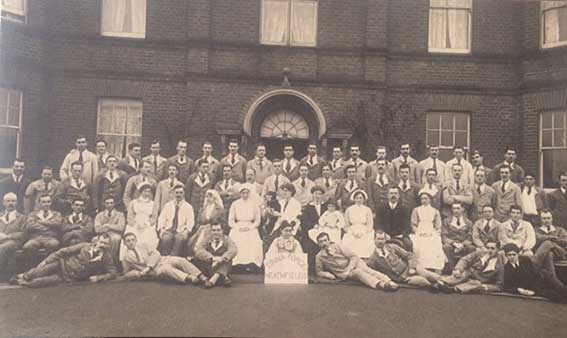
'I have attached a copy of a postcard in my collection of a
group of people with a board written on it "DINNA FORCE, HEATHFIELDS"
on the back of the card is written "Feb 1918". I don't think the
building in the background exists anymore: the building is possibly the
one on Peter [Higginbotham]'s workhouse site [see Links]
in a photo dated c1937. I think this building faced the Woodbridge Rd
side of the site and has been demolished, there is a very similar
doorway still on the site hidden by a modern flat roof extension at the
entrance 15 of today's hospital (also pictured on Peter's site dated
2001) but the windows above the door canopy are different to the
postcard windows.' Thanks
to Steve for this enigmatic image with its even more enigmatic
inscription: 'DINNA FORCE'? The
only linguistic context we can come up with is in the Scottish dialect
e.g. "Dinna force me to answer ye."Presumably,
this is an assemblage of institution staff at the end of the First
World War.
Heathfields in the 21st century
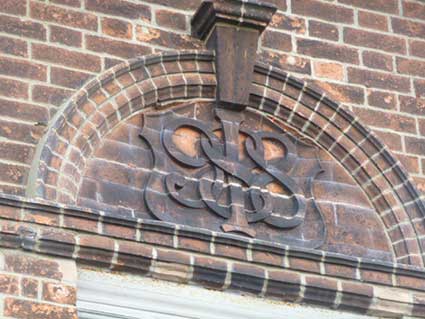
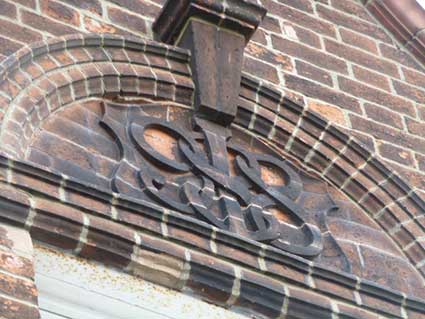 2016 photos courtesy Steve Girling
2016 photos courtesy Steve Girling
'I have attached photos of the concealed door of the old
Heathfields workhouse behind the current entrance 15 at the hospital,
there is also a couple of photos of the date 1898 in the brickwork on
the 'cartouche' at the top, on the photos of the back façade of
the building the 'cartouche' is blank as it would not of been so
visible as it looked over other buildings. Regards, Steve Girling.'
Thanks to Steve for these photographs of the surviving
Heathfields buildings. The dated brickwork tympanum provides
interest on several counts. The beautiful monogram features the
interlaced '1 8 9 8',
although you would have to know a bit of the background to put
the numerals in the correct order (see also the date monogram
in the interior spandrels of the Corn Exchange).
Moreover, we have stated above that 'the new workhouse was built
from 1896'; this suggests that this particular wing, at least, was
opened in 1898.
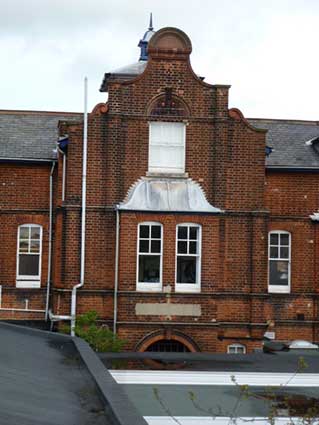
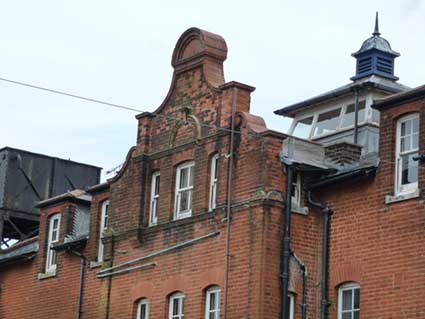
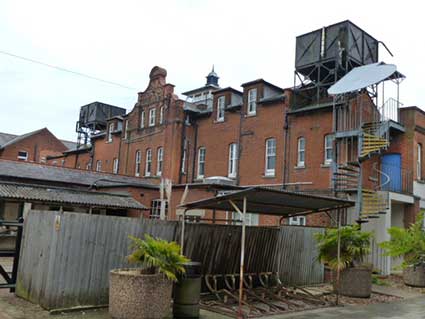
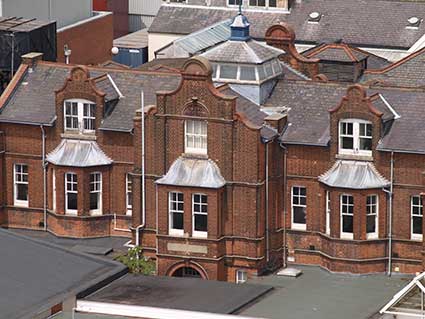
See the Reading list for Ray Whitehand's
book: Four tenements and a
hay house.
See also Peter Higginbotham's
excellent resource Workhouse: the
story of
the Workhouse in Britain (see Links)
for much more information plus images about Ipswich –
and Suffolk – Union Workhouses.
Home
Please email any comments and contributions by clicking here.
Search Ipswich
Historic Lettering
©2004 Copyright throughout
the Ipswich Historic Lettering site: Borin Van Loon
No reproduction of text or images without express written permission

 Photos courtesy Steve Girling
Photos courtesy Steve Girling




 Oakum pickers
Oakum pickers
 1902 map
1902 map



 2016 photos courtesy Steve Girling
2016 photos courtesy Steve Girling


